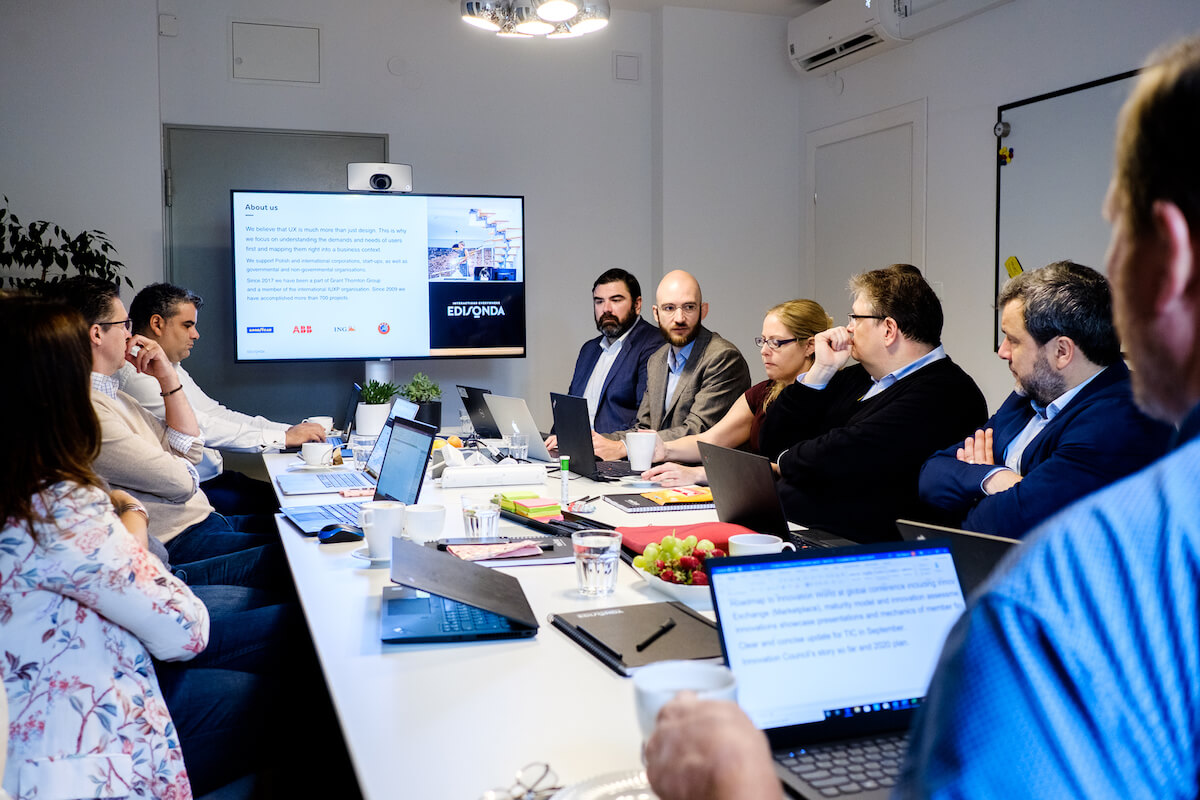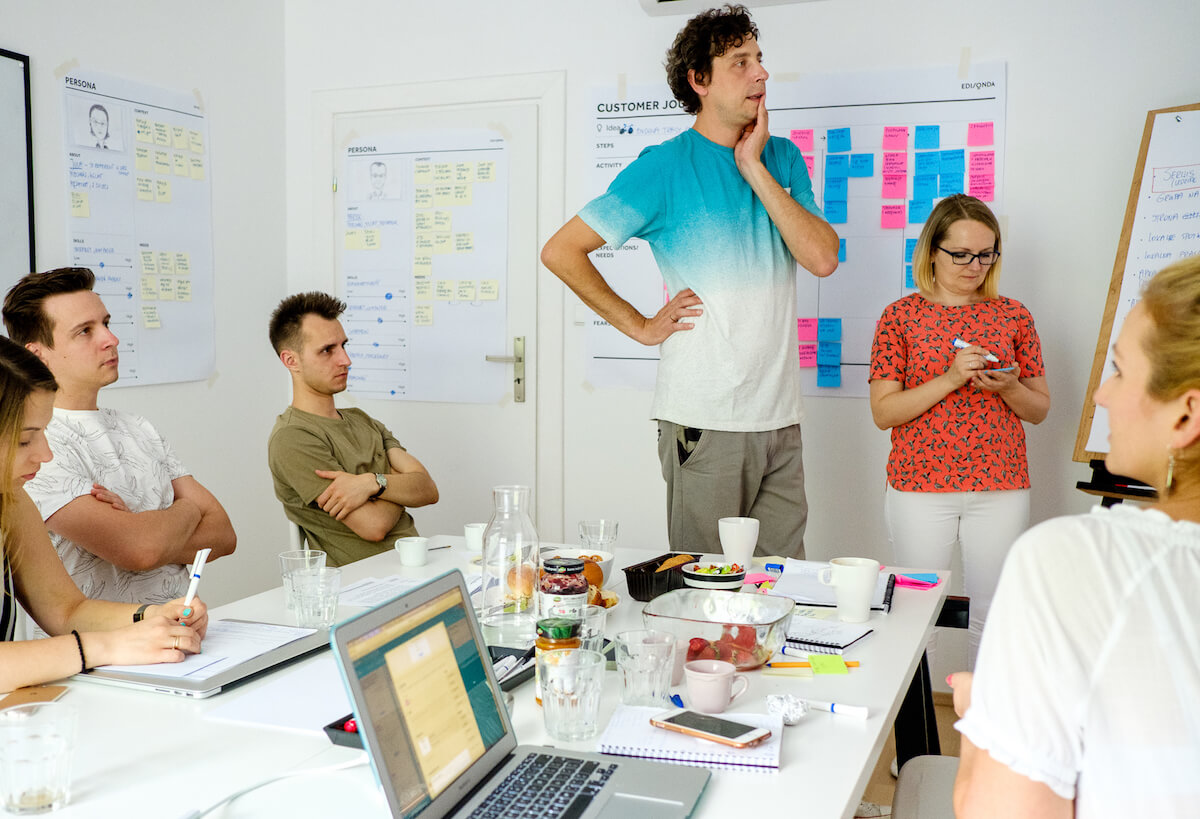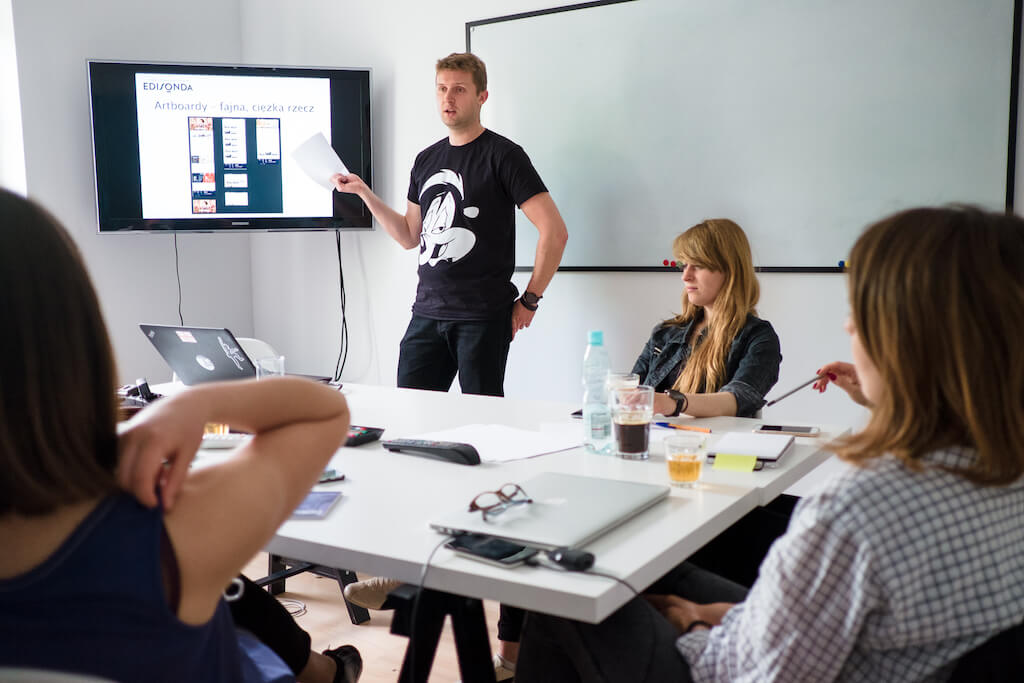Product Discovery Sprint helps companies to validate ideas for digital products effectively. This product exploration exercise helps to create a shared understanding of the problem to solve and gives initial answers on how to solve it. If you want to know more about how to run Product Discovery Sprint and its advantages over other methods, read our article. Here are some practical tips to get the most out of the Discovery Sprint.
1. State clear goal
To make the whole process effective, we start with defining a goal for the ongoing sprint. Planning a sprint with a clear idea of what the output should be, helps to define the scope and match the activities to the current needs.
It is crucial to ensure that the goal remains transparent to all team members during every stage of the sprint, so all participants can focus their efforts effectively and devise a satisfactory solution. The role of the facilitator is to ensure that all activities during the sprint bring the team closer to achieving the goal.
Sometimes, during the design process, participants can get inspired and come up with excellent ideas which are not directly related to the sprint subject. In this case, it is important to place those ideas in the parking lot. Side ideas should not distract the team from the primary goal, but since they are still great opportunities for future development, they should be written down and evaluated after the sprint.
2. Plan and adjust
Every sprint starts with a preparation week – we plan our work and dig into the subject matter. This design thinking method gives us a well-developed general frame for the sprint structure and tested set of tools, which allows us to conduct it systematically and gather key information in the most optimal way.

Keeping in mind our end goal, we can select the right canvases from our library to reach our objectives. But before we start mapping and creating anything, first, we need to fit all activities into specific timeframes and tailor them to the needs of the organisation and team members. It is best to start with a high-level plan and then dive deeper into more details within phases.
Think about the milestones, and don’t forget to mark any important deadlines. Make sure that everyone has a clear sprint agenda with sessions planned and calendar invites sent to the right people. Remember that the plan is not set in stone, and changes are welcome, but it is important to inform your team and relevant stakeholders of any changes and let them know why. Revisit the roadmap frequently to track progress and adjust it when necessary.
3. Consult multidisciplinary
Creating digital solutions is teamwork. Think about people in your organisation affected by the new solution and invite them to cooperate. Besides the designers, product owners, and decision-makers, the perfect team should also include industry specialists with crucial knowledge about market, customer, and business needs. Thanks to their input, we can understand the different business contexts and focus on actual use cases. Similarly, having a person from the development team helps to assess the difficulty of implementation and prioritise tasks.
Keep in mind that not every person needs to be present at every meeting. A number of participants can make a difference, especially during the workshops when everyone should actively contribute. Having too many people in one room will delay the process and limit chances for expressing thoughts freely. On the other hand, when the group is too small, it may result in missing crucial knowledge, lacking diverse perspectives, and ending up with false assumptions. Usually, the optimal number of participants is 5-8. Think about whose knowledge will be the most beneficial and when. If we need input from more people, we can always divide them into smaller groups, conduct separate sessions and combine insights.
4. Define roles and responsibilities
Once you have all the essential people on board, it is important to decide who will do what and how to collaborate effectively across all roles. Keeping all tasks clearly distributed among all team members prevents some work from being unnecessarily duplicated while others remain not taken care of at all.

The most optimal situation is when the right people are involved in the right way, and no one is distracted by unnecessary activities. In simple words, decision-makers should make decisions, designers design, and idea founders keep everything in line with their idea. It’s helpful to define roles and their scope at the beginning of the process. Assign a name to a role and make a to-do list for every person, so it is straightforward for everyone where to go in case of questions. Sticking to the role and ensuring that all tasks are fulfilled by the right person makes the whole process quicker and easier, prevents misunderstandings, and helps deal with fuzzy responsibility within a group.
5. Frequent short meetings are better than rare long ones
We conduct the Product Discovery Sprint to validate some ideas quickly. To keep all teams focused and ready for action, it is essential to avoid downtimes and promptly resolve any blockers that may appear during the process. To help with that, it is worth planning the regular meetings upfront at the beginning of the sprint.
During those meetings, the team should be able to ask questions, dispel doubts and get necessary feedback. The sessions are not supposed to be long, but they should be regular. Even 15-30 min every day allows to keep everyone on track, and if there is nothing to discuss, the meeting can be skipped, but booked space in our calendars provides an option to address issues as they come.
Keeping the meetings short prevents unnecessary time waste and makes them easier to fit between other daily activities, especially for those stakeholders who are not deeply involved in the process.
6. Being prepared makes the process shorter and more effective
The key to the success of the Discovery Sprint is the involvement of all team members. To achieve that, every participant needs to cooperate and co-create the solution.
All activities during the sprint are connected and planned in sequences, so that insights from the previous exercise serve as the basis for the next activity. In the beginning, the design team usually shares a list of initial questions, and depending on the answers, we plan the whole process onwards. Then during the business design workshops, we map the entire concept and ask clarifying questions, and sometimes there is “homework” to do before the next meeting.
Do you want to know more about Product Discovery Sprint?
Engaging in all those activities is essential to come up with the most fitting outcomes. Remember that we are here to help you make your idea tangible, and getting answers promptly helps us achieve this goal. Don’t hesitate to let the facilitator know if you don’t know something or need more time to fulfill a task. The information that something is missing or hasn’t been tested yet is also valuable.
7. Think systemically
Even if, during the Product Discovery Sprint, we are focusing only on the fragment of the target solution, it is essential to maintain the view of the whole landscape. Are there any other solutions in your company that tackle a similar issue? Can we add a new answer to the existing one? Are there any other teams in your organisation that are working on something similar? Can we join forces? Mapping the ecosystem keeps us in the context of other tools and ensures that the new solution fits right in. It allows us to save time and money and to take advantage of lessons learned in other projects.
The key aspect of systemic thinking is also the universal Design System across all products. Standard components and similar processes’ behaviour make everything look coherent and easier to use. If your organisation already has one, share it with us. This way, we can follow the guidelines, optimise our design process, and the concept will fit right into the target solution. If you are creating the Minimum Viable Product (MVP) or don’t have the Design System for your existing product yet, we will use our library of components, which can serve as the right foundations for building a consistent interface. If you want to learn more about the reasons to implement the Design System in your company, read our article.
8. Feedback is everything
The outcomes of the product discovery sprint will serve as a basis for creating a target solution. Your idea will be visualised with key screens, and you will receive functional and business specifications, which will ease cost estimations and help to get the stakeholders’ approval.
After the product discovery sprint, it is worth summarising everything and highlighting key insights for an executive summary. A short presentation allows you to move your idea further and introduce the whole concept to new people without making them dig into workshop materials or going through the documentation.
This helps keep them engaged during the presentation and encourages them to explore aspects that interest them the most. Remember to share the outcomes of the product discovery sprint within your organisation and validate the concept with the target users. You can conduct simple usability testing or do qualitative interviews. Gather as much feedback as possible to make sure the solution that will be built serves its goal and fulfills the needs of end users and the organisation.
9. Time to pivot
Don’t worry if, during the Product Discovery Sprint, it’s getting clear that the idea is more complex than it seemed, some things need to be thought through once again, while others don’t make sense altogether. Actually, it happens quite often, and this is precisely why the Discovery Sprint was conducted in the first place! Otherwise, you would have figured this out later after spending much more money, time, and effort.
After such a sprint, you will have an overview of the issues and a clear list of blockers to resolve. We will provide our recommendations, and you will be able to iterate on that. Maybe even plan the next discovery sprint with the revisited idea. Don’t get discouraged and remember that even the most successful products sometimes reach some dead ends, and those are valuable lessons.
10. Don’t be afraid to share your ideas
Last but not least, remember that the Product Discovery Sprint is a creative process, so all ideas are welcome. Your input may inspire others to figure out a new way to solve the problem or shed light on an issue that hasn’t been considered yet. Don’t assume that other people don’t talk about something because it is obvious. Feel free to share your doubts, propose solutions, and show examples of things that work for you well. The more input you give, the more satisfying the results will be.




